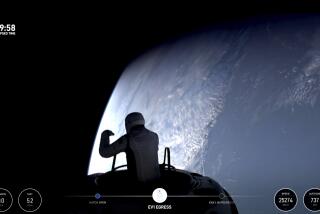American, Russian Team Up for Spacewalk to Repair Mir
- Share via
MOSCOW — Two astronauts who were ferried to the troubled Mir space station by the shuttle Atlantis carried out a five-hour repair mission in open space Wednesday, patching damage from a June collision, packing up experiments and testing emergency jet-powered backpacks.
The action-packed spacewalk was the second success story in the course of a few hours, as the 10-member crew aboard the linked U.S. and Russian spacecraft managed to bring on line a new computer to replace the faulty one that has played havoc with Mir’s power management and navigation.
The spacewalk by American Scott Parazynski and Vladimir Titov, a Russian on loan to the National Aeronautics and Space Administration for shuttle duty, took cooperation between the former Cold War adversaries to new heights. Titov wore a NASA spacesuit--a first for a Russian--and, with his experience of three previous spacewalks, took the lead in the heavy workload set by Houston.
Titov and Parazynski left the pressurized comfort of Atlantis and first tackled the job of wrestling three suitcase-sized experiment boxes from Mir’s exterior into the shuttle cargo bay for transport back to Earth.
Those packages, known as the Mir Experimental Effects Payload, had been mounted outside the Russian space station to test the consequences of persistent bombardment by micrometeorite particles, explained Kate Maliga of the NASA office at Russian Mission Control. She described the particle collectors as “a kind of space-age flypaper” that should help scientists determine what kind of conditions the Alpha International Space Station will have to endure when it begins taking shape in space in 1999.
The main task of the spacewalk was fitting a cone-shaped cap over an area of the Spektr research module feared damaged when an unmanned cargo capsule crashed into its hull June 25, knocking solar collectors out of commission and puncturing and depressurizing the module used by NASA.
Officials are still unsure where the main hole in Spektr is located and say further spacewalks will be needed to find and patch it.
The last of the work undertaken by Titov and Parazynski was testing of new emergency propulsion systems contained in the backpacks astronauts wear during spacewalks. The hand-operated power packs would allow an astronaut accidentally cut loose from his or her tether to maneuver back to the mother ship, Maliga said.
More to Read
Sign up for Essential California
The most important California stories and recommendations in your inbox every morning.
You may occasionally receive promotional content from the Los Angeles Times.














